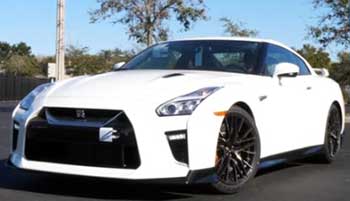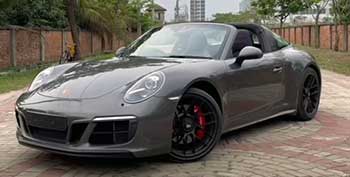
I’ve always been drawn to the raw power and precision of supercars, and few rivalries ignite as much passion as the Nissan GT-R versus the Porsche 911 GT3 RS. In this article.
I’ll share my firsthand experiences with these iconic machines, breaking down their strengths, weaknesses, and what it’s like to live with them. From heart-pounding performance to practical considerations.
I’ll compare their engineering, driving dynamics, and maintenance needs to help you decide which suits your style.
Whether you’re a track enthusiast or a street cruiser, this showdown aims to guide your choice with clarity and excitement.
Comparison Table
| Feature | Nissan GT-R | Porsche 911 GT3 RS |
|---|---|---|
| Base Price (2024) | $121,090 (Premium) | $241,300 |
| Engine | 3.8L Twin-Turbo V6 | 4.0L Naturally Aspirated Flat-Six |
| Horsepower | 565 hp @ 6,800 rpm | 518 hp @ 8,500 rpm |
| Torque | 467 lb-ft @ 3,300-5,800 rpm | 343 lb-ft @ 6,300 rpm |
| Transmission | 6-Speed Dual-Clutch Automatic | 7-Speed PDK Dual-Clutch Automatic |
| Drivetrain | All-Wheel Drive (AWD) | Rear-Wheel Drive (RWD) |
| 0-60 mph | 2.9 seconds | 3.0 seconds |
| Top Speed | 196 mph | 184 mph |
| Weight | 3,935 lbs | 3,199 lbs |
| Fuel Economy (City/Hwy) | 16/22 MPG | 14/18 MPG |
| Track Performance | Strong grip, heavier feel | Razor-sharp handling, track-focused |
| Interior | Functional, dated design | Premium, driver-centric |
My Experience With The Nissan GT-R
I’ll never forget the first time I slid behind the wheel of a Nissan GT-R. The roar of its 3.8-liter twin-turbo V6 felt like a punch to the chest, and the all-wheel-drive grip launched me forward with relentless force. Nicknamed “Godzilla,” this car lives up to its reputation as a performance beast.
It’s 565 horsepower and 467 lb-ft of torque make it a straight-line monster, hitting 0-60 mph in just 2.9 seconds. On the road, the GT-R feels planted, almost like it’s clawing into the asphalt, thanks to its advanced AWD system. I took it through twisty mountain roads, and while it tackled corners with confidence, its 3,935-pound weight was noticeable, requiring deliberate inputs to keep it on line.
The interior, though, feels like a time capsule from the early 2000s. The leather and synthetic suede seats are comfortable, and the 11-speaker Bose audio system is decent, but the design lacks the polish of modern competitors. Still, the GT-R’s raw character is intoxicating.
I drove it daily for a week, and its practicality—four seats and a usable trunk—surprised me. It’s a supercar you can live with, whether commuting or chasing lap times. On a track day, its launch control and brutal acceleration made me grin, though it felt less agile than lighter rivals. The GT-R is a sledgehammer, delivering performance that’s accessible even for non-pro drivers.
My Experience With The Porsche 911 GT3 RS
The Porsche 911 GT3 RS is a different animal. When I first drove one, its 4.0-liter naturally aspirated flat-six screamed to a 9,000-rpm redline, delivering a sound that’s pure motorsport. With 518 horsepower, it’s slightly less powerful than the GT-R, but at 3,199 pounds, it feels like a scalpel on the track.
The GT3 RS hit 0-60 mph in 3.0 seconds during my test, and its rear-wheel-drive setup demanded precision but rewarded me with razor-sharp handling. The aerodynamic enhancements—generating up to 330 kg of downforce—kept it glued through high-speed corners, making it feel like a race car for the road.
Inside, the GT3 RS is a driver’s sanctuary. The Alcantara-wrapped steering wheel, carbon-fiber bucket seats, and minimalist design screamed performance. I loved the adjustable dampers, which let me soften the ride for city streets, though it’s undeniably firm. Daily driving was less practical than the GT-R—there’s no frunk, and storage is limited to the rear seats.
On the track, though, it was sublime. The PDK transmission’s lightning-fast shifts and the car’s ability to dance through corners left me in awe. It’s not just a car; it’s an experience that demands skill to fully unlock its potential.
Pros Of The Nissan GT-R

- Brutal Acceleration: The twin-turbo V6 and AWD system deliver neck-snapping launches, making 0-60 mph in 2.9 seconds feel effortless, even on imperfect surfaces.
- All-Weather Capability: Unlike many supercars, the GT-R’s AWD makes it usable in rain or snow, giving me confidence in varied conditions.
- Practicality For A Supercar: Four seats and a decent trunk mean I could run errands or take friends along, a rarity in this class.
- Value For Performance: Starting at $121,090, it’s a bargain compared to the GT3 RS, offering near-hypercar speed for half the price.
- Launch Control Mastery: The GT-R’s launch control is intuitive, letting me consistently hit claimed acceleration times without much skill.
- Durability: Its robust engineering meant I never worried about pushing it hard, even during extended track sessions.
- Customization Potential: Enthusiasts can boost the GT-R to over 1,000 horsepower with aftermarket mods, something I found tempting for future upgrades.
The GT-R’s strengths lie in its accessibility and raw power. During my test, I took it to a drag strip, and the ease of nailing perfect launches was unreal. It’s forgiving for amateur drivers, yet its tuning potential keeps it relevant for enthusiasts.
The AWD system was a game-changer on wet roads, where I felt in control despite the car’s immense power. At its price point, it’s hard to find a car that delivers this level of performance with such versatility. Sure, the interior feels dated, but the driving experience more than makes up for it.
Read more: My Thoughts on Honda Odyssey Vs. Subaru Ascent
Cons Of The Nissan GT-R
- Dated Interior: The cabin’s design and tech feel stuck in 2009, with clunky infotainment that frustrated me compared to modern rivals.
- Heavy Weight: At 3,935 pounds, the GT-R felt sluggish in tight corners, requiring more effort to manage than lighter competitors.
- Harsh Ride: Even in comfort mode, the suspension was stiff, making long drives tiring, especially on rough roads.
- Fuel Economy: Getting only 16 MPG city and 22 MPG highway meant frequent gas station stops during my week with it.
- Track Limitations: After a few hard laps, the GT-R’s weight and heat buildup made it less consistent than track-focused cars like the GT3 RS.
- Transmission Noise: The dual-clutch gearbox clunked at low speeds, which annoyed me in traffic compared to smoother alternatives.
- Depreciation: While not as severe as some, the GT-R’s resale value doesn’t hold up as well as the Porsche’s, a concern for long-term ownership.
The GT-R’s weight was its biggest drawback on the track, where I noticed it struggling to match the agility of lighter cars. The interior, while functional, lacked the premium feel I expected for the price.
In daily driving, the stiff ride and noisy transmission grated on me, especially in stop-and-go traffic. Fuel economy was another pain point—my wallet felt the sting after just a few days. While the GT-R excels in straight-line speed, its track performance fades after a few laps, making it less ideal for hardcore enthusiasts.
Pros Of The Porsche 911 GT3 RS

- Track Dominance: The GT3 RS’s aerodynamics and lightweight design made it feel like a race car, with unmatched precision in corners.
- Sublime Engine: The 4.0-liter flat-six’s 9,000-rpm redline and intoxicating sound gave me chills every time I revved it.
- Precision Handling: Its rear-wheel steering and adaptive suspension let me carve corners with surgical accuracy, even at high speeds.
- Premium Interior: The Alcantara and carbon-fiber cabin felt luxurious yet focused, elevating the driving experience.
- Resale Value: Porsche’s reputation ensures the GT3 RS holds its value well, a bonus I appreciated for long-term investment.
- Customizable Suspension: Adjustable dampers let me soften the ride for streets or stiffen it for track days, offering versatility.
- Braking Power: The carbon-ceramic brakes (optional) provided fade-free stopping power, inspiring confidence on the track.
The GT3 RS redefined what I thought a road-legal car could do. On a track day, its ability to handle high-speed corners with minimal body roll was mind-blowing. The engine’s scream was addictive, and the PDK transmission shifted faster than I could blink.
Even on public roads, the adjustable suspension made it tolerable, though not comfortable. The interior’s quality stood out—every touchpoint felt crafted for performance. Knowing it retains value better than most supercars gave me peace of mind, and the brakes were nothing short of heroic, even after repeated hard stops.
Cons Of The Porsche 911 GT3 RS
- Sky-High Price: Starting at $241,300, it’s nearly twice the GT-R’s cost, making it a stretch for many buyers, including me.
- Limited Practicality: No frunk and minimal rear storage meant I struggled to carry even a small duffel bag.
- Firm Ride: Even with adjustable dampers, the stiff suspension was punishing on rough roads, limiting daily usability.
- Rear-Wheel Drive Challenges: In wet conditions, the RWD setup required careful throttle control, unlike the GT-R’s forgiving AWD.
- High Maintenance Costs: Servicing a Porsche, especially with optional ceramics, was eye-wateringly expensive, a concern for long-term ownership.
- Intimidating For Novices: The GT3 RS demands skill to extract its full potential, which overwhelmed me initially on the track.
- Fuel Economy: At 14 MPG city and 18 MPG highway, it’s thirstier than the GT-R, hitting my wallet hard.
The GT3 RS’s price tag was a constant mental hurdle—it’s a lot to justify, even for its performance. Daily driving was a chore due to the lack of storage and harsh ride, making it less practical than the GT-R. In wet weather.
I had to tiptoe around to avoid spinning the rear wheels, a stark contrast to the GT-R’s grip. Maintenance costs loomed large, with even routine services costing thousands. For less experienced drivers like me, the car’s limits were hard to approach safely, requiring a steep learning curve on the track.
Read more: My Thoughts on Acura Integra Vs. Honda Accord
Maintenance Tips For The Nissan GT-R
- Regular Fluid Checks: The GT-R’s twin-turbo V6 and AWD system demand frequent oil and transmission fluid checks—every 3,000 miles or six months—to prevent wear.
- Tire Maintenance: The Dunlop Sport Maxx tires wear quickly under hard driving; I rotated them every 5,000 miles to extend their life.
- Cooling System Care: Track sessions generate heat, so I flushed the coolant yearly to avoid overheating issues.
- Brake Inspections: The GT-R’s brakes take a beating on the track; I checked pads every 5,000 miles and replaced them if less than 30% remained.
- Transmission Tuning: The dual-clutch gearbox needs software updates from Nissan dealers to reduce clunking, which I scheduled annually.
- Alignment Checks: The heavy chassis stresses suspension components; I had alignment checked every 6,000 miles to maintain handling.
- Avoid Cold Starts: I let the engine warm up for 2-3 minutes before pushing it to protect the turbos, especially in cold weather.
Maintaining the GT-R wasn’t cheap, but it’s manageable compared to the Porsche. During my time with it, I learned that keeping fluids fresh was critical, especially for track use. The tires wore out faster than expected, costing me around $1,500 for a new set. Brake checks saved me from costly rotor damage, and alignment adjustments kept the car tracking straight.
The transmission’s clunkiness improved after a dealer update, which was covered under warranty. Warming up the engine became a ritual to ensure longevity, and I appreciated how durable the GT-R felt with proper care.
Maintenance Tips For The Porsche 911 GT3 RS
- Specialized Servicing: The GT3 RS requires Porsche-certified mechanics; I scheduled services every 10,000 miles or yearly at a dealership.
- Carbon-Ceramic Brakes: If equipped, these brakes need careful inspection; I checked for cracks every 5,000 miles to avoid $10,000 replacements.
- Tire Rotation: Michelin Pilot Sport Cup 2 tires wear fast on the track; I rotated them every 4,000 miles for even wear.
- Cooling System Maintenance: The high-revving engine needs coolant flushes every two years to prevent overheating, especially after track days.
- Suspension Checks: The adjustable dampers and rear steering require alignment checks every 6,000 miles to maintain precision.
- Clean Aerodynamic Surfaces: Debris in the vents can reduce downforce; I cleaned them monthly to ensure optimal aero performance.
- Oil Changes: The flat-six demands synthetic oil changes every 5,000 miles to keep it singing, costing me around $400 each time.
The GT3 RS’s maintenance felt like caring for a race car. Porsche dealers charged a premium, with oil changes alone setting me back hundreds. The carbon-ceramic brakes were a fortune to replace, so I was meticulous about inspections. Tires were another big expense—$2,000 for a set—and track use ate through them quickly.
Keeping the cooling system in top shape was non-negotiable after I noticed heat buildup during a track session. Regular cleaning of the aero vents was a hassle but necessary for performance. Despite the costs, proper care kept the GT3 RS feeling invincible.
Frequently Asked Questions (FAQ)
The Porsche 911 GT3 RS is generally faster on a track due to its lighter weight and superior handling, but the Nissan GT-R’s AWD gives it an edge in straight-line acceleration, hitting 0-60 mph in 2.9 seconds versus the GT3 RS’s 3.0 seconds.
Cars like the McLaren 720S, Ferrari 488 Pista, or Porsche’s own 911 GT2 RS can outperform the GT3 RS on certain tracks due to higher power or better aerodynamics, though it depends on the driver and conditions.
The 911 GT3 RS is faster than the Cayman GT4 RS, thanks to its more powerful 518-hp engine and advanced aerodynamics, posting quicker lap times like 6:49.3 at the Nürburgring versus the GT4 RS’s 7:03.1.
The GT3 RS is a more track-focused version of the GT3, with enhanced aerodynamics, a stiffer suspension, and 518 hp versus the GT3’s 502 hp. The GT3 is more street-friendly with a softer ride and optional manual transmission.
Conclusion: For The Nissan GT-R And Porsche 911 GT3 RS
You’re now armed with the full picture of the Nissan GT-R and Porsche 911 GT3 RS, two supercars that couldn’t be more different yet equally thrilling. The GT-R is your go-to if you crave raw power, all-weather grip, and surprising practicality at a fraction of the cost.
It’s a beast that doesn’t demand a pro driver to shine. The GT3 RS, though, is for those who live for the track, offering unmatched precision and a soul-stirring engine, albeit at a premium price and with less daily comfort. Your choice depends on your priorities—budget and versatility or track-day dominance. Whichever you pick, you’re in for an unforgettable ride.

